Abstract
This article reviews the mineral composition and potential health benefits of Zamzam water. Zamzam water is different from natural water in terms of minerals and radiological features. The miracle of Zamzam is its continuous flow since 2000 BC. The appearance of the Zamzam well led to the foundation of the settlement of the Makah valley. Zamzam water quenches the thirst and shows potential to cure numerous diseases. Different studies have been conducted to explore the mythical qualities of this water; still there is a need to conduct widespread research and to explore its healthcare benefits, mineral profile, and technological perspectives. Recent animal studies showed that Zamzam was effective against cancer, as it thwarts the development of tumors.
INTRODUCTION
Water is a basic need and is essential in carrying out various physiological functions in the human body.[ 1 ] Humans can survive without food for a month, but they can survive without water for only seven days.[ 2 ] Our planet has huge reservoirs of water, but fresh drinking water is scarce. Only 2.8% of the total water on earth is freshwater; the rest is saltwater that is hard to use. This corresponds to about 12.5–14 billion cubic meters of water that is available annually,[ 2 ] for human, animal, and agricultural purposes. For agricultural purposes, it takes 3000 to 5000 liters of water to grow 1 kg of rice.[ 1 ] Similarly, it takes 1000 tons of water to grow 1 ton of wheat.[ 3 ] This is interesting to note, when water-scarce countries, such as those in the Middle East, import grains. They use not only the grains but also the water required to grow the grains, and therefore, need to use water resources efficiently.[ 2 ]
Although the world’s water sources are limited, and existing sources are depleting rapidly, there is a source of water called Zamzam that is providing water to billions of people. For Muslims, it is holy water, which has quenched people’s thirst since the dawn of human history. This source of water is located in the Mecca area, one of the most sacred cities for Muslims. This city is located in the western part of Saudi Arabia about 70 km south of the city of Jeddah on the coast of the Red Sea. Geographically it can be located at latitudes 21° 26ʹ 48′′ N, longitude 39° 53ʹ 46′′ E, with an elevation of about 1399 ft. above mean sea level (Fig. 1).[ 4 ]
Figure 1 Location of Zamzam well.[ 4 ]
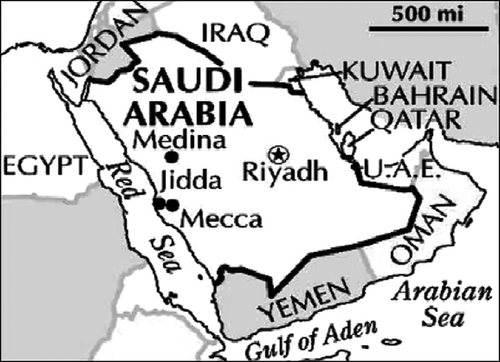
BACKGROUND
Brief anecdotes that mention Zamzam are described in holy books of various religions, including the Tawrah (Old Testament/Torah), the Bible, and the Quran. As narrated in these holy books, Zamzam is the holy water and is termed as a great gift from God (referred to as Allah in the Quran). It is allegedly an offshoot from a holy spring (currently present in the form of a well) in the barren desert surrounding Mecca. Islamic history presents a detailed account of it in the following context. Long ago, holy Prophet Ibrahim (Abraham) with his wife Hajara and baby Ismail Peace came to Mecca. To fulfill God’s will, Prophet Ibrahim returned home, leaving Hajara and the infant in the desert. Soon afterward, the water that Ibrahim left with them ran out, and Hajara was no longer able to breast-feed her child. Hajara became thirsty, and so did her son, who started crying and became unsettled due to extreme thirst. Hajara walked impatiently seven times between the hills of Al-Safa and Al-Marwa searching for water. After the seventh round, she heard the voice of the Angel Jabrail, who led her to a place where he kicked the earth, and water emerged on the surface. She gathered water in her hands and collected it into a container; the water bubbled up again each time she scooped.[ 6 ] Since water was flowing at a high rate at that time, the angel thus uttered the word “Zamzam,” which means “slow down.” Many other names have been given to the water of Zamzam; among them are “Zammam,” “Zumazim,” “Shubaa,” “Hazmat al-Malik,” and “Rakdat Jibril.”[ 7 ] Some scholars mention 11 other names of Zamzam; these include “The Sealed,” “That which is Clung to,” “The Watering,” “The Quenching,” “The Impulse of Jibril,” “The Kick of Jibril,” “The Repletion,” “The Healer of Sickness,” “The Satisfier of Hunger,” and “The Well of Abd al-Muttalib.”[ 5 , 6 ]
Structure and Hydrogeology of the Well
The Zamzam well is hand-excavated and is about 30.5 m deep, with an internal diameter ranging from 1.08 to 2.66 m. In hydrogeologic terms, the well lies within the wadi Ibrahim, which runs through the Holy City of Mecca and taps ground water from the wadi (valley) alluvium, to a much lesser extent, and from the underlying fresh bedrock (Fig. 2). The well is now housed in a basement room, protected by glass panels that allow a clear view of the well. Electric pumps are used to draw water from the well, replacing the previous ropes and buckets. No visitors except dignitaries are allowed to enter the well room and its surroundings. Outside the room, there exists a service area, where cold Zamzam water fountains and dispensing containers are provided for drinking purposes. Recently, the Al-Haram Tawaf area has been extended to cover the entrance to this area, and it is no longer accessible to pilgrims. Instead, cold Zamzam water fountains and dispensing containers are now placed at the periphery of Tawaf area.[ 7 ]
Figure 2 Shape and dimension of Zamzam well. (Color figure available online.)
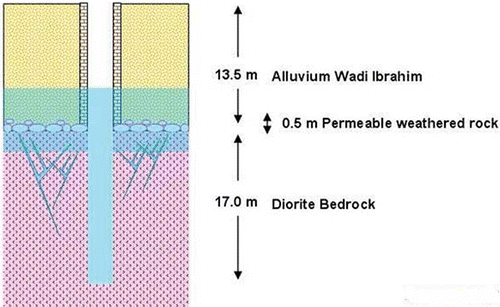
The upper 13.5 m of the well is excavated in the sandy alluvium of the wadi Ibrahim and the lower 17 m in the underlying diorite bedrock. In between sandy alluvium and diorite bed rock, there is a thinner layer (0.5 m) of permeable weathered rock. Most of the alluvial section of the well is lined with stone masonry, except for the uppermost 1 m, which has a reinforced concrete collar. The weathered rock section is lined with stone and provides the main water entry into the well (Fig. 2).
Physico-Chemical Analysis of Zamzam Water
Different studies have been conducted to determine the physical and chemical parameters of Zamzam water. The first analytical study of the Zamzam well was carried out by an Egyptian commission to Hijaz in 1935.[ 8] Later, two independent detailed analyses were performed in 1971 by the Ministry of Agriculture Riyadh (Saudi Arabia) and its consultants.[ 9] The comparison of the results from the Egyptian Commission study and Ministry of Agriculture study are presented in . These studies opened up new avenues of research for international researchers, and the first international publication on the chemical analysis of Zamzam water was reported in 1976 by the American Water Resource Association,[ 9] and then a second report was issued by Abu-Samn[ 10] in 1982. Abu-Samn studied water from three different wells (the Zamzam well, the Dawoodiyah well, and the Musfalah well) located adjacent to the Zamzam well. The distance between Zamzam and Dawoodiyah was about 900 m, whereas Zamzam and Musfalah were 2800 m apart. His research led to the conclusion of higher total dissolved solids (TDS) in nearby water sources as compared to the Zamzam water ().


Mineral Profile of Zamzam Water
Advanced techniques for multi-elemental and hydrochemical study of Zamzam water were carried out by Naeem and Alsanussi.[ 11 ] Researchers employed neutron activation, inductivity coupled plasma, and other available classical techniques to analyze the water samples. These techniques revealed 34 elements in Zamzam water with calcium (Ca), magnesium (Mg), sodium (Na), and chloride (Cl) in higher concentrations than natural water. The elements antimony (Sb), beryllium (Be), bismuth (Bi), bromine (Br), cobalt (Co), iodine (I), and molybdenum (Mo) were less than 0.01 ppm. Only traces of chromium (Cr), manganese (Mn), and titanium (Ti) were detected in Zamzam water. Hydrochemical study of Zamzam water indicated that it is a sodium chloride water of meteoritic origin. The amount of four toxic elements, arsenic (As), cadmium (Cd), lead (Pb), and selenium (Se), was much below the danger level for human consumption. Many scientists suggest that certain peculiarities make Zamzam’s water healthier, such as a higher level of calcium.[ 13 ]
Elevated concentrations of arsenic (As) metal were reported in the print and audio visual media in the Zamzam water, especially in the bottled Zamzam water available in some European countries.[ 13 ] However, repeated analysis of the Zamzam water by Alfadul and Khan[ 13 ] verified that arsenic (As) levels ranged between 9.68 and 10.75 μg/L, which lies within the admissible range set by different regulatory agencies and also in agreement with Saudi Arabian Standard Organization (SASO) standards for drinking water.

Chemistry of Cations and Anions
The solute in Zamzam water is important from a health point of view and is expressed in terms of cations and anions. Calcium is the major divalent cation and often complexed with carbonates and bicarbonates in Zamzam water (Fig. 3 and ).[ 4 ] The distribution of other major cations and anions present in the form of soluble salt includes magnesium bicarbonate, magnesium sulphate, sodium, and potassium chloride. The long residence time with aquifer materials of basic lava origin (basalt) can account for the origin of the ferro-magnesium minerals of the calcium and magnesium.[ 4 ] The enrichment of Zamzam water with calcium reflects its asserted ability to satisfy both thirst and hunger, while the slightly enriched values of potassium and sodium reflect its alleged ability to affect the human nervous system.[ 15 ] Most of the cations and anions in the Zamzam water are relatively higher in concentrations, but all of them are in agreement with the maximum contaminant limits set by different regulatory agencies ()—except nitrates, which were found exceeding the prescribed limits.[ 13 ]
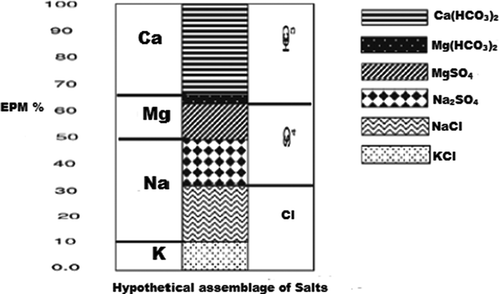

Comparison with Natural Drinking Water and Bottled Water
Cations and anions analysis of normal and Zamzam water samples by Saad et al.[ 14 ] using capillary ion technique revealed higher levels of both cations and anions in Zamzam samples as compared to other water samples. It is evident that quality parameters and limits for Zamzam water are quite different in comparison to tap water and bottled water. The supposed health-promoting value of Zamzam may be attributable to these balanced levels of mineral content (Fig. 4). A comparison of Zamzam water (), available bottled drinking water, and distilled water was also carried out by El-Zaiat.[ 15 ] The study led to the conclusion that Zamzam water has a rich essential mineral profile; TDS were in the acceptable range (ranging up to 1000 mg/L). The Zamzam water also has higher electrical conductivity (1390 μS/cm) as compared with bottled water (740 μS/cm).
Figure 4 Electropherogram of Zamzam water (reprinted from Saad et al.[ 43 ] with permission from Elsevier).
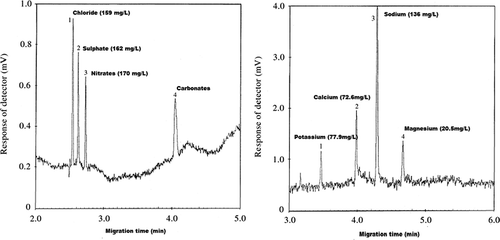

Isotopic Compositon of Zamzam Water
The isotopic composition of Zamzam water was carried out by Al-Gamal.[ 4 ] The isotopic composition was expressed as O-18 and H-2. The cross plot of O-18 versus H-2 is shown in Fig. 5.[ 3 ] The low content of O-18 (–10.04‰) and H-2‰ (–90.36‰) are attributed to paleoclimatic recharge. The examination of this figure reveals that Zamzam is even more exhausted in delta values if compared with some of the selected trans-boundary aquifers containing palaeowaters all over the world.[ 4 ] Palaeowaters are supposed to be depleted in O-18 with respect to recent water, if precipitated under more humid and cooler periods. The interpretation is that recharge occurred during the last Holocene humid period, and that the aquifer is now discharging ancient groundwater resources. This is in agreement with the observed decrease in the Zamzam piezometric level (while Zamzam at the time of Prophet Ismail was flowing, it is now 30 m from the ground surface). The y-intercept value of 10 in the global meteoric water line (GMWL) equation is called the deuterium excess. The deuterium excess for Zamzam water was fitted to a slope of eight. The deuterium excess is a function of the relative humidity during evaporation and could vary from 4 to 24 for a relative humidity variation range of 60 to 90% and temperature of condensation range of 0 to 20°C.[ 16 ] The deuterium excess for Zamzam water is 10, reflecting that the origin of Zamzam rain was different from that of the other palaeowaters. It is difficult to say whether this difference is due to global variations in the origins and atmospheric circulations of air masses during the period of recharge—or an “instantaneous” situation corresponding to exceptional events of precipitation (and recharge). Auyun Musa palaeowater on the eastern side of the Gulf of Suez, though showing a difference in salinity, reflects more or less the same isotopic signature with that of Zamzam (H-2 = –85, O-18 = –11). Auyun Musa water aging, calculated on the basis of C-14, ranges between 25,000 to more than 40,000 before present (BP).[ 17 ] On the basis of similarity in isotopic signature, Zamzam could have the same age range. The following general palaeoclimatic picture was recently proposed for the late Quaternary of both hemispheres, for latitudes of up to about 25° (Zamzam is at a latitude of 21°): 40,000–20,000 BP, heavy rainfall and high lake levels; 17,000–12,000 BP: inter-tropical aridity, dune building, and lake desiccation; 11,000–5000 BP: high precipitation and very high lake levels, which are most probably the prevailing climatic conditions during the first discovery of Zamzam.[ 4 ]
Figure 5 Cross plot of δ18O versus δ 2H for Zamzam water.[ 4 ]
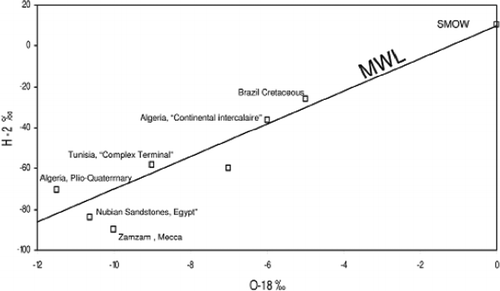
Radiological Features of Zamzam Water
Humans are exposed naturally to ionizing radiation from a number of sources, which include cosmic rays and natural radionuclides in air, food, and drinking water.[ 18 , 19 ]Underground water often has high levels of naturally occurring radionuclides, such as those of the uranium, thorium, and radium decay chains.[ 18 ] Well water can be a significant source of 222Rn in room air.[ 19 ] The US Environmental Protection Agency has proposed a maximum concentration level (MCL) of 11 Bq/L for radon in drinking water. This proposed MCL is based primarily on the inhalation risk from the distribution of waterborne 222Rn.[ 20 ] Another radionuclide, radium, with chemical properties similar to calcium, is one of the major sources of the radioactivity found in water and food. Because of the long half-life of 226Ra (T1/2 = 1620 y), it can accumulate in the human body for a long time. Therefore, the harmfulness of 226Ra dissolved in water is said to be about 40 times that of 90Sr.[ 21 ] According to the US National Committee on Radiation Protection,[ 22 ] the maximum permissible concentration of 226Ra in drinking water, 0.148 Bq/L, is less than that of any other radionuclides. The radiological characteristics of Zamzam water is expressed as 238U (uranium) series (226Ra and 214Bi), 232Th (thorium) series (228Ra (radium), 228Ac (actinium), and (titanium) 208Ti) and also in accumulation to 40K (potassium) and 137Cs (cesium)[ 4 ] ().

Optical Profile in Comparison with Natural Water
The Abbe number of Zamzam water was about 2.4 times higher than that of bottled water; similarly, the single oscillator constants for Zamzam water was 1.5 times higher than natural water.[ 15 ] The refractive indices of Zamzam water were measured at six different wavelengths by El-Zaiat.[ 15 ] He concluded that the dispersion values of optical parameters (at λ = 550 nm) for Zamzam water were smaller than those of bottled and distilled waters by 0.4 times. These different optical properties of Zamzam water may be due to the chemical structures of rocks around the Zamzam well. The detail overviews of optical parameters were presented in .[ 15 ]

Crystallography and Nanotechnological Perspectives of Zamzam Water
Radin et al.[ 23 ] claimed that the human consciousness has an effect on the molecular structure of water. Emoto’s hypothesis has evolved over the years of his research. Emoto claimed that high-quality water forms beautiful and intricate crystals, while low-quality water has difficulty forming crystals. According to Emoto, an ice crystal of distilled water exhibits a basic hexagonal structure with no intricate branching, and positive changes to water crystals can be achieved through prayer, music, or by attaching written words to a container of water. Emoto published several volumes of a work titled Messages from Water, which contains photographs of water crystals next to essays and words of intent.
Recently, quantum biophysical semeiotics experiments have offered new evidence about the existence of a connection between water memory and healing information, exactly following Emoto’s interesting hypothesis about the changes to water crystals achieved by music and songs.[ 24 , 25 ] Emoto passed different sound frequencies through Zamzam water and observed variable crystal behaviors based on crystallography techniques among Zamzam water and water samples from other parts of the world. Interestingly, he noticed that this water had a special interaction and reaction when the words of Allah in the Quran were recited to it. Emoto brought a few drops of Zamzam water and recited the “Bismillah” (in the name of Allah, the Beneficent, and Most Merciful) in Arabic and noticed a unique arrangement of the water particles in shape. He observed the water particles taking distinct shape in comparison with other water particles shapes taken from other parts of the world. Emoto was not able to crystallize Zamzam water even after diluting Zamzam by 1000 times. However, he got a uniquely shaped crystal after freezing.[ 26 ] Two crystals were formed (Fig. 6), one on top of the other, and assumed a unique form. He coined the term “Nano” for Zamzam water,[ 26 ] and further research was carried out by Arida et al.[ 27 ] The study made a new thin-film silver micro-sensor by utilizing Zamzam water, tap water, and underground water. Their results showed higher recovery (191.4 ppm) of silver in Zamzam, followed by underground water (166.6 ppm), and tap water (92.2 ppm).
Figure 6 Zamzam water crystal.[ 26 ] (Color figure available online.)
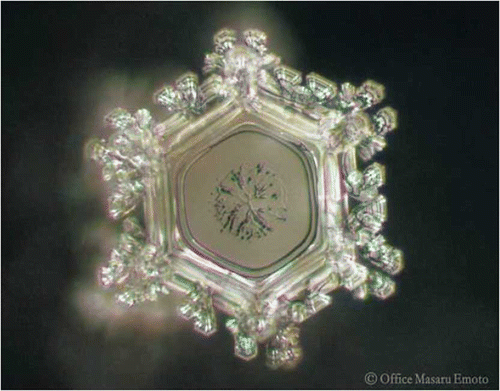
Healing Properties of Zamzam Water
Zamzam is unique in its natural characteristics because it is “hard carbonated type water” in nature. It has been proven that there is no microbial growth in the water from the Zamzam well. The potential healing properties of Zamzam water are described next.
Zamzam Water and Aquaporin (AQP) Stimulation
Zamzam water has the ability to stimulate AQPs;[ 28 ] these are water channels that form across a membrane; they play critical roles in controlling the water content of cells. These channels are widely distributed in all kingdoms of life, including bacteria, plants, and mammals.[ 29 ] They have some connections with membrane proteins that belong to the family of major intrinsic proteins (MIP) and form pores in the membranes of biological cells.[ 30 ] More than ten different AQPs have been identified in the human body. All of these AQPs may be stimulated through Zamzam water. Ali et al.[ 30 ] studied the effect of Zamzam water on AQPs stimulation by using immunohistochemistry and endometrial biopsy in 50 healthy fertile females divided into two groups: group 1 with an intake of 500–750 c.c. of Zamzam water for one month, and group 2 with an intake of tap water. They found significant increase in endometrial AQPs (AQP2, AQP3, and AQP4) with expression of new AQPs (AQP7, AQP9, and AQP10) in Zamzam water. The results suggest that Zamzam water provides a defense against several diseases, such as congenital cataracts, nephrogenic problems, and diabetes. Such phenomenon was confirmed through various techniques including radioimmunoassay, nanotechnology, crystalline electro-microscopy, specific refractive index, number single oscillator, and optical parameters assay. All of these benefits are attributable to Abbe’s number of Zamzam water that is completely different from waters from other sources. [ 11 , 15 , 30 , 31 ]
Zamzam Water and Stimulation of Reproductive Systems
Zamzam water was used in the treatment of implantation failure, for stimulation of endometrial prolactin, α and β defensin, luteinizing hormone (LH), endometrial vascular endothelial growth factor (VEGF), and angiopoietin receptors.[ 32 ] Furthermore, Zamzam water cause upregulation of gap junctional inter-cellular communication and connexin 43 antibodies in endometrium. Recently, Ali et al.[ 32 ] demonstrated that Zamzam water stimulates stem cells’ differentiation in the endometrium. This phenomenon is triggered due to the high calcium and magnesium content of Zamzam. Also, the water provides more support to many other biochemical processes in the endometrium, including its vital role as coenzyme during the formation of immunoglobulin.[ 32 , 33 ] Zamzam stimulates the formation of implantation windows through stimulation of AQPs because it contains high contents of fluorides, contributing to its strong antimicrobial action. Zamzam water also acts as an antioxidant as it stimulates endometrial nitric oxide (NO). It also stimulates endometrial brain derived neurotrophic factor (BDNF). It is reported that Zamzam water is a new modality for repeated failed intracytoplasmic sperm injection (ICSI). However, a large number of randomized studies are needed to test the efficacy of this new line of treatment.[ 32 ] Similarly, cervical insufficiency abortion can be controlled by Zamzam water, because it activates the autologous human peripheral blood mononuclear (PBM) cells that have a positive fetal effect and have no fetomaternal complications.[ 33 ]
Zamzam Water and Dental Caries
A comparative study between Zamzam water and other sources of water on the prevalence of dental caries and their severity in school girls was carried out by Al-Zuhair and Khounganian.[ 34 ] Clinical examination revealed that, in the mixed dentition group, no statistical significant differences were detected, whereas among the permanent dentition group, the mean decayed, missing, filled teeth (DMFT) score was the lowest in all the children using Zamzam water. The possible reason for this significance is the higher level of fluorides in Zamzam water. The role of fluoride in the prevention of dental caries is very well established. Dean et al.[ 35 ] reported an inverse relationship between the prevalence of caries and drinking water with different fluoride levels, stating that exposure to water containing about 1 ppm fluoride in drinking water reduces caries experience by 50%, whereas fluoride levels higher than 1.5 ppm in temperate countries is known to cause dental fluorosis. A large number of studies have confirmed the beneficial effects of fluoride in drinking water.
Zamzam Water and Cancer
Dietary guidelines around the world recommend increased consumption of plant foods to combat chronic diseases such as cancer, cardiovascular diseases, diabetes, and osteoporosis.[ 36 ] Zamzam water has unique oncolytic properties and has a strong anti-inflammatory effect. Zamzam water has a strong antitumor necrosis factor (TNFα) and effect on interleukin I (IL1).[ 37 ] Zamzam water has oncolytic action through an indirect influence on endocrine immunology and the growth system of the body. Initially, it was observed in an experimental mice model.[ 38 ] To study the oncolytic action of Zamzam water, the experimental mice were injected with azoxymethane (AOM)[ 39 ] to induce a colon tumor. Biopsies were taken from the non-tumor tissue to prepare microarray data for differentially expressed genes. Experimental mice were fed with 500 cc Zamzam water daily for one month, and again a biopsy was taken after Zamzam water intake. A significant (P < 0.05) reduction in the tumor size was observed that finally diminished in long-run study. One possible reason for the disappearance of the tumor is the biochemical nature of Zamzam water (). Zamzam water directly affects the populations of lymphocytes residing in the colon, which in turn affect tumor genesis by specific immune mechanisms, resulting in decreased tumor size.[ 38 , 40 ]
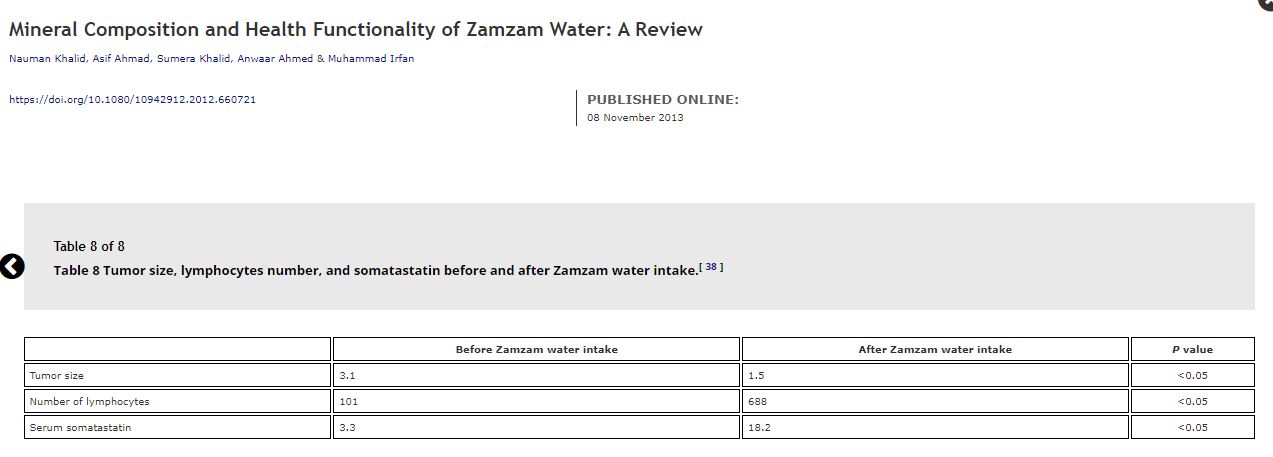
Ali et al.[ 41 ] carried out experiments with 100 healthy fertile females divided into two groups: group 1 with 500–750 cc Zamzam water for one month and group 2 with ordinary tap water. The study looked for three markers well known for their oncoprevention qualities: Bikunin, Lunasin, and Bowman Brikinhibitor. The results showed significant increase in all three inhibitors in the group with Zamzam water.
Zamzam Water and Agriculture
Tap water is one of the essential factors for planting. Numerous investigations have focused mainly on the effects of water or drainage water on growth and yield of plants. The effects of water types on growth parameters of wheat and broad beans were investigated by an Egyptian group. They used Zamzam water alone, a combination of Zamzam water with tap water, Zamzam with treated water and tap water, treated water alone, and combinations of these two. The sole use of Zamzam water, or a combination of Zamzam, with either treated water or tap water resulted in pronounced increases in the percentage of seed germination, shoot length, and the fresh and dry weights of the shoots. Similarly, the percentage of flowers in broad bean plants watered with Zamzam was considerably higher in comparison with other water treatments.[ 42 ]
Physiological parameters and yields of Vicia faba L. and Triticum vulgare L. irrigated with Zamzam, desalinized, and “normal” well water were recently studied by Hamed et al.[ 43 ] They concluded that crops irrigated with Zamzam water gave the highest values of yield, soluble carbohydrates, total carbohydrates, protein, and total nitrogen contents. The normal well water recorded moderate results, while the desalinized water (as control) recorded the lowest values. The proximate composition of the two planted yields was given in Figs. 7 and 8. Similarly, Alsokari[ 44 ] found a positive effect on growth and protein content of lentil seedlings when irrigated with Zamzam water. Irrigation with Zamzam water increased the protein, RNA, DNA, and total phenolic and antioxidant contents in lentil seedlings.
Figure 7 Effect on irrigation with Zamzam, desalinized, and well water on elemental composition in Triticum vulgare and Vicia faba.[ 43 ] (Color figure available online.)
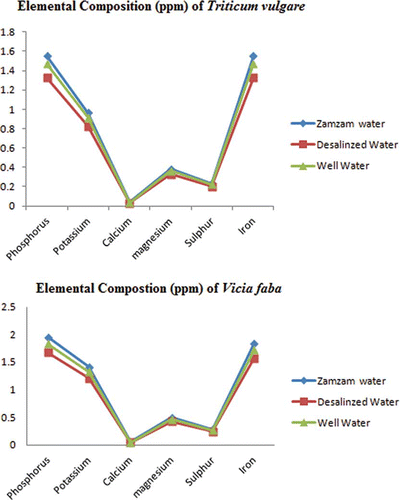
Figure 8 Effect on irrigation with Zamzam, desalinized, and well water on total carbohydrates, total proteins, total lipids, and nitrogen composition in Triticum vulgare and Vicia faba.[ 43 ] (Color figure available online.)
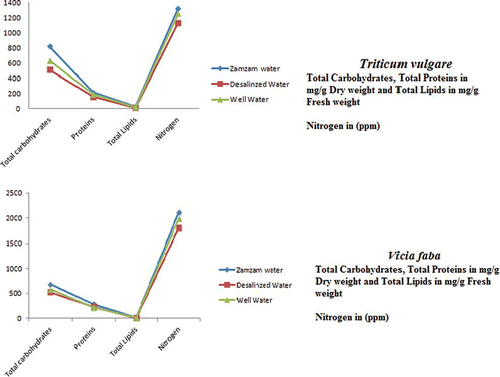
CONCLUSION
A lot of benefits of Zamzam have been elucidated by local folk, but little scientific exploration on the subject has taken place to date. However, studies involving human, plant, and animal research have shown great potential benefits from Zamzam in fighting various human ailments and developed cancerous growth. Positive responses in affecting plant growth have also been demonstrated. This review confirms the balanced mineral and nutritional composition of Zamzam water. The unique mineral composition of Zamzam water ensures several nutraceutical and functional benefits that work in synergism with other agents to impart beneficial effects, or to thwart harmful effects. Comprehensive research is required to explore its unique properties and mysteries. Numerous health implications offer great opportunities for researchers to explore the relationship between Zamzam water’s chemistry and its nutraceutical benefits.
REFERENCES
- Cazier, J.B. and Gekas, V. 2001. Water activity and its prediction: A review. International Journal of Food Properties, 4: 35–43. [Taylor & Francis Online], [Web of Science ®], [Google Scholar]
- Vidyasagar, D. 2007. Global minute: Water and health–walking for water and water wars. Journal Perinatol, 27(1): 56–58. [Crossref], [PubMed], [Web of Science ®], [Google Scholar]
- Bouman, B.; Tuong, T.P. Growing rice with less water, equivalent of two to three Olympic size water pools to grow one ton of rice http://www.iwmi.cgiar.org//assessment/FILES/pdf//publications/other/Issues.pdf (http://www.iwmi.cgiar.org//assessment/FILES/pdf//publications/other/Issues.pdf) (Accessed: 10 August 2011). [Google Scholar]
- Al-Gamal, S.A. 2008. “Remarks on the isotopic composition of Holy Water of Zamzam, Mecca area”. In In World Environment Magazine(we); World Environment Group; 19–22. [Google Scholar]
- Holy Quran. Surah Ibrahim (14). Verse 37 http://quran.com/14 (http://quran.com/14) (Accessed: 11 September 2011). [Google Scholar]
- Ahmad, M.A.A. and Ibrahim, M.S. 1996. The Water of Zamzam, 8–51. London: Dar Al Taqwa Ltd. [Google Scholar]
- SGS Zamzam. Saudi geological survey http://www.sgs.org.sa/English/Topics/Pages/Zamzam.aspx (http://www.sgs.org.sa/English/Topics/Pages/Zamzam.aspx) (Accessed: 15 September 2011). [Google Scholar]
- Al, Azraqi. News of Mecca 1141 A.H. 1728. [Google Scholar]
- 1971. Watson Consultant for the Ministry of Agriculture and Water. Riyadh, Saudi Arabia [Google Scholar]
- Abu-Samn, R.H. A. 1982. Scientific overview on Sacred Water of ZamzamWell: Some Qualitative Chemical and Biological Analysis. Pakistan Journal of Scientific Research, 34(3–4): 7–12. [Google Scholar]
- Naeem, N. and Alsanussi, H.; Almohandis. 1983. A. Multielemental and hydrochemical study of holy Zamzam water. Journal of the New England Water Works Association, 97(2): 159–169. [Google Scholar]
- Guéguen, L. and Pointillart, A. 2000. The bioavailability of dietary calcium. Journal of the American College of Nutrition, 19: 119S–136S. [Taylor & Francis Online], [Web of Science ®], [Google Scholar]
- Alfadul, S.M. and Khan, M.A. 2011. Water quality of bottled water in the kingdom of Saudi Arabia: A comparative study with Riyadh municipal and Zamzam water. Journal of Environmental Science and Health Part A, 46(13): 1519–1528. [Taylor & Francis Online], [Web of Science ®], [Google Scholar]
- Saad, B., Pok, F.W., Sujari, A.N.A. and Saleh, M.I. 1998. Analysis of anions and cations in drinking water samples by capillary ion analysis. Food Chemistry, 61(1/2): 249–254. [Crossref], [Web of Science ®], [Google Scholar]
- El-Zaiat, S.Y. 2007. Inherent optical properties of Zamzam water in the visible spectrum: dispersion analysis. The Arabian Journal for Science and Engineering, 32(2A): 171–180. [Web of Science ®], [Google Scholar]
- Yurtsever, Y. and Buapeng, S. 1991. Compartmental modelling approach for simulation of spatial isotopic variations in the study of groundwater dynamics, A case study of a multi-aquifer system in the Bangkok Basin, Thailand: IAEA: Vienna. [Google Scholar]
- Rognon, P. and Williams, M.A.J. 1977. Late quaternary climatic changes in Australia and North Africa: A preliminary interpretation. Palaeogeography, Palaeoclimatology, Palaeoecology, 21(4): 285–327. [Crossref], [Web of Science ®], [Google Scholar]
- Alam, M.N., Chowdhury, M.I., Kamal, M., Ghose, S., Islam, M.N. and Anwaruddin, M. 1999. Radiological assessment of drinking water of the Chittagong region of Bangladesh. Radical Protection Dosimetry, 82(3): 207–214. [Crossref], [Web of Science ®], [Google Scholar]
- 1988. “UNSCEAR, United Nations Scientific Committee on the Effects of Atomic Radiation”. In Sources and Effects of Ionizing Radiations. Report to the General Assembly; New York, United Nations [Google Scholar]
- US EPA. Code of Federal Regulations 40 Part 141. National Primary Drinking Water Regulation, U.S.A. 1986 [Google Scholar]
- The, Higuchi, H. 1981. Analysis of radium in the environmental samples, Radioisotopes, 30: 618 [Google Scholar]
- 1954. “NCRP. National Bureau of Standards”. In Handbook No 52; National Committee on Radiation Protection USA [Google Scholar]
- Radin, D., Hayssen, G., Masaru, E. and Kizu, T. 2006. Double-blind test of the effects of distant intention on water crystal formation. Explore: The Journal Science and Healing, 2(5): 408–411. [Crossref], [Web of Science ®], [Google Scholar]
- Stagnaro, S. Quantum biophysical semeiotics evidences of water-memory-information by means of music energizing action: Caramel’s experiment. Journal of Quantum Biophysical Semeiotics http://www.sisbq.org/uploads/5/6/8/7/5687930/wmi_music_2011.pdf (http://www.sisbq.org/uploads/5/6/8/7/5687930/wmi_music_2011.pdf) (Accessed: 25 November 2011). [Google Scholar]
- Stangnaro, S.; Caramel, S. Two prayer experiment: The effectiveness of different kinds of prayers through QBS assessment. Journal of Quantum Biophysical Semeioticsaccessed kkkNovember 25, 2011 http://www.sisbq.org/uploads/5/6/8/7/5687930/twoprayers_2011.pdf (http://www.sisbq.org/uploads/5/6/8/7/5687930/twoprayers_2011.pdf) [Google Scholar]
- Emoto, M. 2004. Love Thyself: Message from water, Vol. 3.50–51, Tokyo: HADO: Kyoikusha. [Google Scholar]
- Arida, H., Mohsen, Q. and Microfabrication, Schöning, M. 2009. characterization and analytical application of a new thin-film silver microsensor. Electrochimica Acta, 54: 3543–3547. [Crossref], [Web of Science ®], [Google Scholar]
- He, R.H., Sheng, J.Z., Luo, Q., Jin, F., Wang, B., Qian, Y.L., Zhou, C.Y., Sheng, X. and Huang, H.F. 2006. Aquaporin-2 expression in human endometrium correlates with serum ovarian steroid hormones. Life Sciences, 79(5): 423–429. [Crossref], [PubMed], [Web of Science ®], [Google Scholar]
- Agre, P. 2006. The aquaporin water channels. Proceedings of the American Toracic Society, 3(1): 5–13. [Crossref], [PubMed], [Google Scholar]
- Ali, A.F.M., Cosemi, E., Kamel, S., Mohammed, S., Elhefnawy, M., Farid, L. and Shaker, S. 2009. “13th International Water Technology Conference, IWTC”. In Miracle of Zamzam water: the effect on human endometrial aquaporin, 1515–1520. Egypt: Hurghada. [Google Scholar]
- El-Kashef, H. 1994. Optical and electrical properties of materials. Review of Scientific Instruments, 65(6): 2056–2061. [Crossref], [Web of Science ®], [Google Scholar]
- Ali, A.F.M., Hassain, M. and El Hosani, A. 2009. “13th International Water Technology Conference, IWTC”. In Zamzam water a new modality for failed repeated intra cytoplasmic sperm injection, 1557–1560. Egypt: Hurghada. [Google Scholar]
- Ali, A.F.M., Rafik, M., Ali, S.M., Hussein, M., Hassan, A., El Husseiny, A. and Farid, L. 2009. “Treatment of cervical insufficiency abortion by Zamzam water activated autologeous human peripheral blood mononuclear cell, modern trend”. In 13th International Water Technology Conference, IWTC, 1533–1541. Egypt: Hurghada. [Google Scholar]
- Al-Zuhair, N.A. and Khounganian, R. 2006. A comparative study between the chemical composition of potable water and Zamzam water and its effect on tooth structure in Saudi Arabia. Saudi Dental Journal, 18(SI) Abst. 071 [Google Scholar]
- Dean, H.T., Arnold, F.A. and Evolve, E. 1942. Domestic water and dental caries, V. Additional studies of the relation of fluoride of domestic water to dental caries experience in 4425 white children aged 12-14 years, of 13 cities in 4 states. Public Health Reports, 57: 1155–1179. [Crossref], [PubMed], [Google Scholar]
- Rao, A.V. and Ali, A. 2007. Biologically active phytochemicals in human health: Lycopene. International Journal of Food Properties, 10(2): 279–288. [Taylor & Francis Online], [Web of Science ®], [Google Scholar]
- Ali, A.F.M., Cosemi, E., Kamel, S., Mohammed, S., Elhefnawy, M., Farid, L. and Shaker, S. 2009. “Zamzam water gene downregulation in uterine Fibrochondrosarcoma cell line”. In 13th International Water Technology Conference, IWTC, 1543–1547. Egypt: Hurghada. [Google Scholar]
- Ali, A.F.M., Cosemi, E., Kamel, S., Mohammed, S., Elhefnawy, M., Farid, L. and Shaker, S. 2009. “Oncolytic action of Zamzam water on azoxyonethone (AOM) induced colon tumors in rats”. In 13th International Water Technology Conference, IWTC, 1521–1526. Egypt: Hurghada. [Google Scholar]
- Hakkak, R., Korourian, S., Ronis, M.J., Johnston, J.M. and Badger, T.M. 2001. Soy protein isolate consumption protects against azoxymethane-induced colon tumors in male rats. Cancer Letters, 166: 27–32. [Crossref], [PubMed], [Web of Science ®], [Google Scholar]
- Pitcher, L.A. and Van Oers, N.S. 2003. T cell receptor signal transmission: Who gives an ITAM. Trends in Immunology, 24: 554–560. [Crossref], [PubMed], [Web of Science ®], [Google Scholar]
- Ali, A.F.M., Cosemi, E., Kamel, S., Mohammed, S., Elhefnawy, M., Farid, L., Zamzam Water, Shaker, S. and Oncopreventive, Action. 2009. In: 13th International Water Technology Conference, IWTC, 1527–1532. Egypt: Hurghada. [Google Scholar]
- Mutwally, H.M.A.; Omar, S.A.M.; Bedaiwy, M. Effect of water types on some growth parameters of wheat and broad bean plants under Al-Baha, KSA environmental condition http://uqu.edu.sa/files2/tiny_mce/plugins/filemanager/files/31/08_Effect_of_Water_Types_on_Some_Growth_Parameters_of_Wheat_and_Broad_Bean_Plants.pdf (http://uqu.edu.sa/files2/tiny_mce/plugins/filemanager/files/31/08_Effect_of_Water_Types_on_Some_Growth_Parameters_of_Wheat_and_Broad_Bean_Plants.pdf) (Accessed: 10 September 2011). [Google Scholar]
- Hamed, B.A., Mutwally, H.M.A. and Omar, S.A.M. 2009. Some physiological parameters of the yields of Vicia faba L and Triticum vulgare L irrigated with Zamzam, desalinized and well water. World Journal of Agricultural Sciences, 5(4): 480–486. [Google Scholar]
- Alsokari, S.S. 2011. Zamzam water-induced changes in growth and biochemical parameters in lentils. Australian Journal of Basic and Applied Sciences, 5(9): 559–563. [Google Scholar]
- Abdul Manan, Y., Muhammad, H.Y. and King, J. 1975. Abdul Aziz University 461 [Google Scholar]
- 1994. “Bottled and unbottled drinking water. Standard No. 409”. In Saudi Arabian Standards Organization (SASO) [Google Scholar]
- U.S. Food and Drug Administration (FDA). 21 CRF part 165: Beverages: Bottled water. 2008 http://www.cfsan.fda.gov /~Ird/fr050609.html (http://www.cfsan.fda.gov /~Ird/fr050609.html) [Google Scholar]
- Annex 4. World Health Organization: Geneva. 2006. WHO, Guidelines for drinking-water quality, 4th [Google Scholar]
- International Bottled Water Association (IBWA). Bottled water code of practice. Alexandria, VA: IBWA. 2008 http://bottledwater.org/public/modelmain.htm (http://bottledwater.org/public/modelmain.htm) [Google Scholar]
- U.S. Environmental Protection Agency (US EPA). National primary drinking water regulations. 2011 http://www.epa.gov /safewater/mcl.html (http://www.epa.gov /safewater/mcl.html) [Google Scholar]
 Sri lanka Muslims Web Portal Diversity and Inclusiveness
Sri lanka Muslims Web Portal Diversity and Inclusiveness



